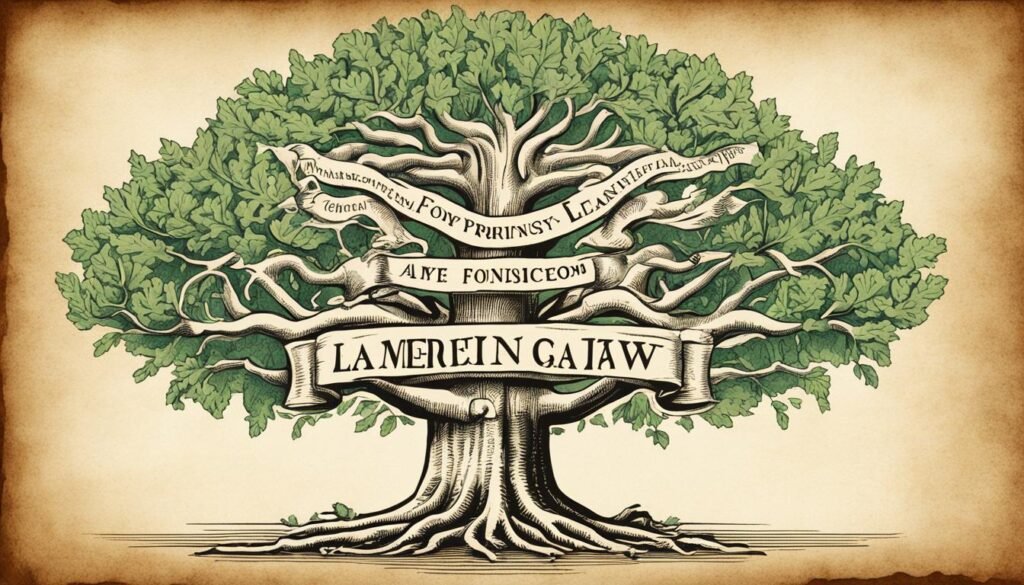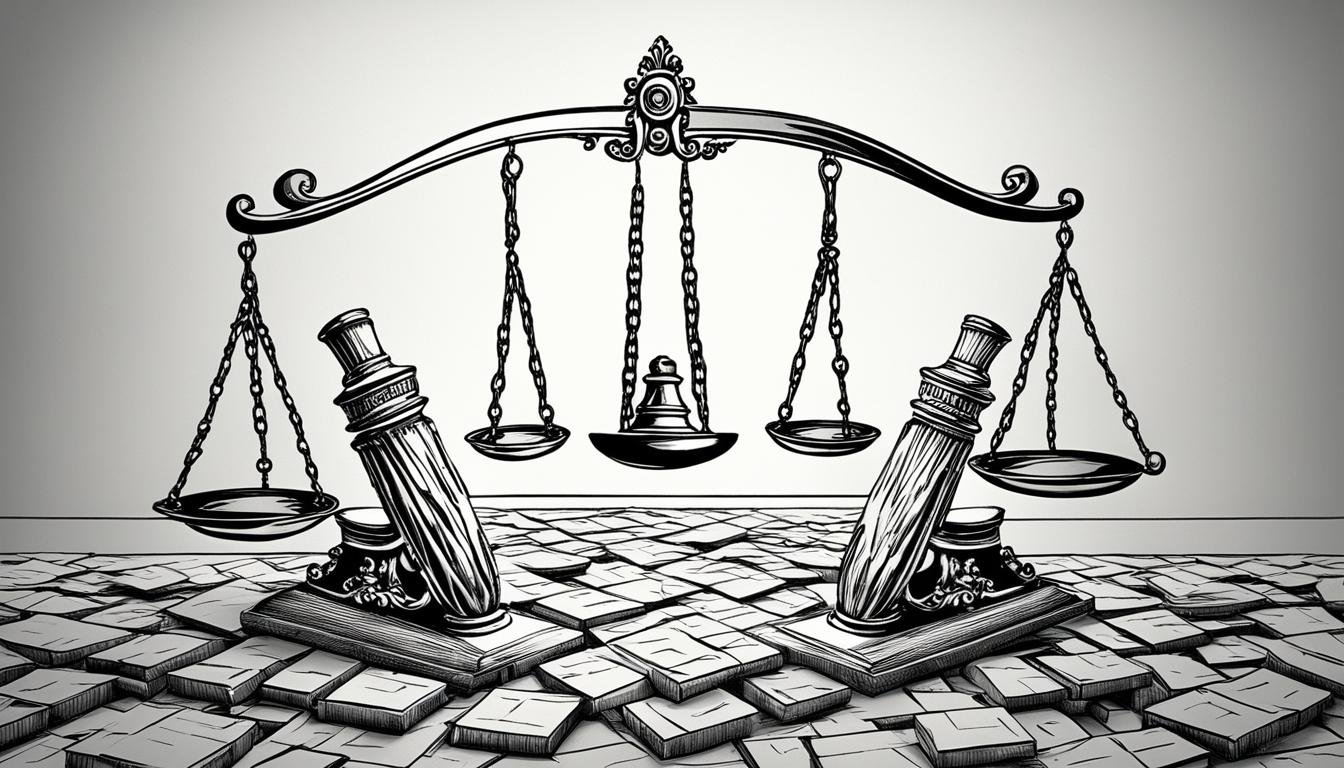Do you know common law is a big deal in places like the U.S., Canada, India, and Australia? Nearly every U.S. state uses this legal system, except Louisiana. It has a strong influence from English law. This makes it a key part of the American legal scene.
Common law relies on past court decisions rather than written laws. It’s critical for decisions in unique cases. Cases where standard laws already in place don’t provide a clear answer. This system in the U.S. dates back to colonial times, coming from British roots.
The heart of common law is the idea of stare decisis, or “to stand by things decided.” This means courts have to follow what’s been decided in the past. Judges must apply and also sometimes shape the law to fit new situations or needs.
Key Takeaways
- Common law is a system of unwritten laws based on legal precedents established by the courts.
- The doctrine of stare decisis requires courts to follow the precedents set by previous court decisions.
- Judges play a crucial role in shaping the law through their interpretation and expansion of legal principles.
- Common law promotes stability, consistency, efficiency, adaptability, and flexibility within legal systems.
- Legal technology advancements, like Westlaw Precision, have improved the efficiency of researching case law.
Understanding Common Law: The Backbone of the American Legal System
The American legal system is greatly influenced by the foundational principles of common law. It values case law precedents through the stare decisis doctrine. This doctrine says lower courts must follow higher courts’ decisions within their jurisdiction.
What Is Common Law?
Common law grows from judicial interpretation and legal reasoning. It isn’t created by formal laws but through cases over many years. This method creates a systematic process for dealing with law, fairness, and justice.
The US common law is different from civil law systems. It doesn’t rely on detailed legal codes but on past court decisions. This makes the law more flexible. Judges use their knowledge to fit the law to specific cases.
Stare Decisis: The Guiding Principle of Common Law
Stare decisis is a key part of the common law. It means courts must follow earlier decisions made by higher courts locally. This ensures laws are applied consistently and fairly over time.
Still, there are times when courts can break from past decisions. This might happen if a decision was clearly wrong or the world has changed. But changing the law is a careful process. The goal is to keep a steady and fair legal system.

“The common law is not a brooding omnipresence in the sky, but the articulate voice of some sovereign or quasi-sovereign that can be identified.”
– Supreme Court Justice Oliver Wendell Holmes Jr.
Common law is known for its ability to change with the times while holding on to its core values. This balance between consistency and adaptation has kept the American legal system strong. It meets the changing needs of society.
Foundational Principles of Common Law
The American legal system is built on the key ideas of common law. These ideas have influenced America’s judicial system for many years. Central to this system is the role of past decisions and the principle of stare decisis. This principle guides how laws are understood and used. It shows the interaction of courts’ levels, their areas of rule, and the difference between types of legal decisions. All together, they create the legal system in the United States.
The Impact of Precedent and Stare Decisis Doctrine
Stare decisis is a major point in common law. It means that courts should follow past decisions. They do this to keep the law applied the same way and to make their rulings predictable. However, not all past decisions are treated the same. Courts are free to not follow suggestions from past cases if they think they’re irrelevant or too old.
Court Hierarchy and Jurisdiction
The U.S. legal system has a clear order. The lower courts are first, followed by appeals courts, and the Supreme Court at the top. This structure is important for deciding which decisions are final and who must follow them. It also shows how federal and state laws interact.
Mandatory versus Persuasive Authority
There are two types of legal weight: mandatory and persuasive. Courts *must* follow mandatory sources, like laws and certain past decisions. Persuasive sources, such as ideas from previous cases, are helpful but not always followed. Knowing this helps to use and understand the law better.
Primary versus Secondary Authority
Legal authorities are also ranked as primary or secondary. Primary sources are set laws and previous big cases. Secondary sources, like articles and books about the law, offer thoughts and suggestions. But, they’re not as strong as primary sources.
Learning about common law basics lets you understand the U.S. legal system. It helps people and companies know how to work within the law. This knowledge is key for ensuring fairness, following correct procedures, and supporting fair and just legal practices.

| Source of Authority | Mandatory or Persuasive | Primary or Secondary |
|---|---|---|
| Constitutions | Mandatory | Primary |
| Statutes | Mandatory | Primary |
| Case Law | Mandatory (binding precedents) | Primary |
| Legal Treatises | Persuasive | Secondary |
| Legal Journal Articles | Persuasive | Secondary |
| Legal Encyclopedias | Persuasive | Secondary |
“The life of the law has not been logic; it has been experience.”
– Oliver Wendell Holmes Jr., Supreme Court Justice
The American Judicial System: Advocacy and Actual Controversy
The American legal system thrives on a method of conflict, where real issues spark intense legal discussions. Courts are only allowed to speak on real cases. They can’t just give advice about what might happen. A case must meet certain rules before a court will even listen. These include important factors like who’s involved, if the issue is settled, and whether it’s the right time to solve it.
Threshold Issues: Standing, Finality, and Ripeness
To start, a party must care enough about the case. They must have something to win or lose. The case also needs to be finished. No more steps should be needed. Lastly, the problem must be ready for a court to step in. Everyone’s rights and responsibilities must be clear, not guesswork.
Avoiding Constitutional Issues and Limiting Scope
Judges keep their decisions as narrow as they can, resolving just the issue at hand. This helps them bypass big constitutional questions when they can. These steps respect the roots of common law, where decisions are based on fundamental principles. By doing this, courts keep their past rulings clear and useful.
“The primary and distinctive purpose of every system of government is the maintenance of justice, the prevention of encroachments upon property, and the peaceable possession of one’s own.” – Benjamin Smith
The American legal system has adapted with the expanding nation, staying true to its historic roots in law. By addressing key issues and keeping their focus sharp, courts are key to maintaining justice and the value of past decisions. These aspects are crucial in upholding law and order.
Conclusion
The basic ideas of common law are very important in America’s legal system. They focus on using the past and current cases to decide what’s right. This makes the law steady, fair, and able to handle new problems.
Understanding common law principles is key for dealing with legal matters. It means using past cases to help your own case and knowing the court system. This is crucial for everyone in law, from new people to experienced lawyers, to achieve success.
The Super attorneys of irvine know common law well. They understand fairness and justice deeply. Because of their knowledge, they can win cases for their clients. Working with them means using the law to protect your rights, making sure fairness wins.
FAQ
What is common law?
What is the principle of stare decisis?
How does the American legal system differ from a civil law system?
What is the difference between mandatory and persuasive authority?
What are the threshold issues that must be satisfied before a federal court will hear a case?
Source Links
- https://legal.thomsonreuters.com/en/insights/articles/what-is-common-law
- https://www.law.berkeley.edu/wp-content/uploads/2017/11/CommonLawCivilLawTraditions.pdf
- https://brill.com/previewpdf/book/9789004313736/B9789004313736-s006.xml
- https://www.law.cornell.edu/wex/legal_systems
- https://montague.law/blog/understanding-the-common-law-right-system/
- https://scholarship.law.vanderbilt.edu/cgi/viewcontent.cgi?article=4636&context=vlr
- https://www.lexisnexis.com/en-us/lawschool/pre-law/intro-to-american-legal-system.page
- https://www.investopedia.com/terms/c/common-law.asp
- https://en.wikipedia.org/wiki/Common_law
- https://ir.lawnet.fordham.edu/cgi/viewcontent.cgi?article=5789&context=flr
- https://usa.usembassy.de/etexts/gov/outlinelegalsystem.pdf
- http://www.law.nyu.edu/sites/default/files/ECM_PRO_060947.pdf
- https://digitalcommons.law.ggu.edu/cgi/viewcontent.cgi?article=1001&context=annlsurvey
- https://lawjournal.mcgill.ca/article/common-law-constitutionalism-through-methodology/
- https://billofrightsinstitute.org/resources/principles-and-virtues

